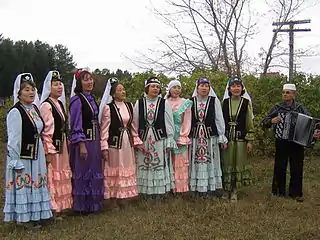Siberian Tatars
Siberian Tatars (Siberian Tatar: сыбырлар, sibirlar), the indigenous Turkic-speaking population of the forests and steppes of South Siberia, originate in areas stretching from somewhat east of the Ural Mountains to the Yenisei River in Russia. The Siberian Tatars call themselves Yerle Qalyq ("older inhabitants"), to distinguish themselves from more recent Volga Tatar immigrants to the region.[3]
сыбырлар, sibirlar | |
|---|---|
 Flag of the Siberian Tatar people | |
| Regions with significant populations | |
| 6,779[1] (2010 census) — 210.000[2] | |
| Languages | |
| Siberian Tatar, Russian | |
| Religion | |
| Sunni Islam | |
| Related ethnic groups | |
| Bashkirs, Kazakhs, several Siberian ethnic groups | |
The word "Tatar" or "Tadar" is also used as a self-designation by some closely related Siberian ethnic groups, namely the Chulym, Shor, Teleut and Khakas peoples.
The 2010 census counted more than 500,000 people in Siberia defining their ethnicity as "Tatar".[4] About 200,000 of them are considered indigenous Siberian Tatars.[5] However, only 6779 of them called themselves "Siberian Tatars".[4] It is not completely clear which part of those who called themselves "Siberian Tatars" consider themselves to be a separate ethnos and which part as a group into the Tatar people, because the census took into account the Siberian Tatars as a subgroup of the Tatar ethnos.[4]
As of 2018, the Siberian Tatars do not yet have public education available in their own language. Lessons in the local schools are taught only in the Russian and Volga Tatar languages; neither language is indigenous to Siberia – ethnic Russian and Volga Tatar immigrants introduced both over two centuries ago.
Population
Siberian Tatars historically lived in the vast territory stretching from around the Yenisei river all the way to the area lying somewhat east of the Ural mountains.
According to the ambassadors of the Siberian Khanate ruler Yediger Khan, who visited Moscow in 1555, the population of "the black people," not counting the aristocracy, was 30,700. In a decree concerning tribute issued by Ivan the Terrible, the population was given as 40,000.
According to the results of the 1897 All-Russia Census, there were 56,957 Siberian Tatars in Tobolsk guberniya. This was the last accurate information about this population. In later censuses, Tatar immigrants from the other regions of Russia were also recorded under the classification of Tatar. The Siberian Tatars tried to avoid the census as much as possible, as they believed that it was an attempt to force them to pay the Yasak (tribute).[6]

Their population in the territory of the current Tyumen Oblast in 1926 was recorded as 70,000; in 1959 as 72,306; in 1970 as 102,859; 136,749 in 1979; 227,423 in 1989; and 242,325 in 2002. According to the results of the 2002 Russian Census, there were 385,949 Tatars living in the oblasts discussed above. (Their territory roughly corresponds to the historical territory of the Siberian Khanate). Of these Tatars only 9,289 identified as Siberian Tatars.
2002 Russian Census recorded a total of 9,611 Siberian Tatars in Russia. Some publications estimated their number in the range of 190,000-210,000.[7] Such significant discrepancy is explained by the fact that the immigrants from the other ethnic groups who are also called Tatar by the Russians were also included in the figure, though most were Volga Tatars.[5]
Origin and ethnogenesis
The term Siberian Tatar covers three autochthonous groups, all Sunni Muslims of the Hanafi madhab, found in southern Siberia. They are remnants of the Khanate of Sibir, which was conquered by Russia in 1582. Geographically, the Siberian Tatars are divided into three main groups, each speaking their own dialect.[3] Although the Siberian Tatar language has been sometimes considered a dialect of Tatar, detailed linguistic study demonstrates that Siberian Tatar idioms are quite remote from Volga Tatar by origin. Siberian Tatars' ancestry was partly from Turkic and Mongol peoples, but their main ancestors are Samoyedic,[8] Yeniseian and Ugrian tribes.
Siberian Tatar language

Siberian Tatar language is, due to the Kipchakization processes during the Middle Ages, many times classified as belonging to the Kipchak–Nogay group of the Kipchak languages.[9] There are approximately as many elements that could be classified in the Upper Altaian language group.
Beginning in the 12th century, the Siberian Tatar language received some Karluk influences. Those Siberian Tatars who are living in ethnically mixed villages where, in the periods after Russian colonization, more numerous Volga Tatars settled, have also been influenced by the Kipchak-Bulgar language.
Siberian Tatar language has different dialects.[9] Since the penetration of Islam until the 1920s after the Russian Revolution, Siberian Tatars, like all Muslim nations, were using an alphabet that had been based on Arabic script. In 1928 they adopted an alphabet based on Latin script, and in 1939 one based on the Cyrillic script. Until 2014, the written language for Siberian Tatars was Tatar, a version based on the grammar rules of Volga Tatars.
In the 21st century, work began on the rationalizing of the Siberian Tatar language. Teams have conducted scientific research in the field of literary language norms of the indigenous population of Siberia. They have published the "Русско-сибирскотатарский словарь = Урысца-сыбырца сүслек" (2010) (Russian-Siberian Tatar Dictionary), and "Грамматика современного сибирскотатарского языка" (2014)(The Grammar of Modern Siberian Tatar Language). International Organization for Standardization ISO 639-3 PA with its headquarters in Washington, awarded in 2013, the Siberian Tatar language classification code 'sty' in New Language Code Element in ISO 639-3. The first person who seriously researched Siberian Tatar language was Gabdulkhay Akhatov, a Soviet Volga Tatar linguist and an organizer of science.
Groups
Tobol-Irtysh Tatars
The Tobol-Irtysh Tatars group is the most numerous out of all 3 groups of Siberian Tatars. They live in the Tyumen, Kurgan and Omsk Oblasts.
The sub-groups are: Zabolotnie (Yaskolbinsk), Tobol, Kurdak-Sargat, Tara, Tyumen-Turin.
Baraba Tatars
Their self-designation is Baraba, and they are found mainly in the steppe of Baraba, in the Novosibirsk Oblast. Their population is around 8,000.
The sub-groups are: Baraba-Turazh, Lyubey-Tunus, Terenin-Choy.
Siberian Bukharans
The Bukhalyks, literally "those from the city of Bukhara" are descendants of 15th- and 16th-century fur merchant colonies from the Caucasus and Central Asia. These settlers have now merged entirely with Siberian Tatars.
Famous Siberian Tatars
- Minsalim Timergazeev – sculptor
- Anvar Kaliev – World War II USSR hero
- Iskander Dautov – World War II USSR hero
- Khamit Neatbakov (Neotbakov) – World War II USSR hero
- Khabibulla Yakin – holder of the Order of glory
- Tamerlan Ishmukhamedov – World War II USSR hero
- Raushan Abdullin – hero of the Russian Federation
- Nafigulla Ashirov – mufti, president of the spiritual association of Muslims of the Asiatic part of Russia
- Galima Shugurova – rhythmic gymnast
- Aleksandr Bashirov – film and theater actor, director and screenwriter (Siberian Tatar mother)
- Abdurreshid Ibrahim – imam, pan-Islamist, journalist, traveller
- Foat-Tach Valeev – World War II USSR veteran, colonel, pedagogist, journalist, historian, sibirologist, ethnographer, professor
- Yakub Zankiev – writer
- Bulat Suleymanov – writer (with also some Georgian ancestry)
- Anas Gaitov – writer
- Rakip Ibragimov – poet
See also
References
- "ВПН-2010". rosstat.gov.ru.
- Сибирские татары // Российский этнографический музей.
- Bennigsen, Alexandre; Wimbush, S. Enders (1986). "The Siberian Tatars". Muslims of the Soviet Empire : A Guide. Bloomington, IN: Indiana University Press. pp. 231–232. ISBN 0-253-33958-8.
- "НАЦИОНАЛЬНЫЙ СОСТАВ НАСЕЛЕНИЯ" (PDF). www.gks.ru. Retrieved 2020-11-05.
- "Siberian Tatars". Archived from the original on 2002-02-27.
- Valeev, F.T. (1993). Siberian Tatars (in Russian). Kazan.
- "Siberian Tatars. Historical reference (in Russian)".
- Levinson, David (1996). Encyclopedia of World Cultures. G.K. Hall. p. 340. ISBN 978-0-8161-1808 -3. Retrieved 2008-04-22.
- Tumasheva D.G.. Dialects of the Siberian Tatar language: experience of the comparative research. Kazan, 1977 (in Russian)